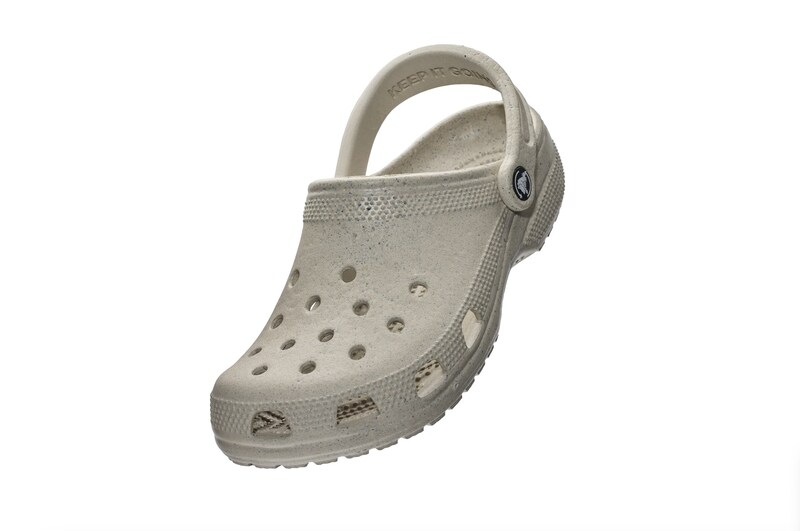recycled plastic. Crocs the comfortable, yet many would say ugly, footwear company has launched a new version of their popular slip-on. Using recycled plastic, recovered from, you guessed it, recycled Crocs. The Keep it Going Classic Clog features 25% recycled content recovered from shoes returned to the manufacturer. The clogs are available in the USA in only one colour, Moon Dust, an “on-trend” almond base with visible specs of recycled shred created from shoes received from ‘Old Crocs.
As with all take-back schemes, this initiative requires further investigation to discover if a real environmental benefit has been achieved. Deanna Bratter, Chief Sustainability Officer, Crocs, said, ‘I want to thank every Crocs fan who brought in or sent back their old Crocs shoes so we could explore ways to give them a new life. This type of circularity program only works when consumers engage and are willing to do some good in the world together.’ While it is great to hear that consumers have made the effort to return their worn shoes it is not clear if the environmental impact of sending or delivering the Crocs has been included in any assessment of impacts. One is left to wonder if any environmental assessment has been conducted. Certainly, no results from such an analysis are included in the press release. Interestingly, none of the press coverage to date appears to have picked up on this omission – but that is hardly surprising in this age of regurgitated press releases passing for news!
In another recent press release, the company claims it ‘has reached 25% bio-circular content in its proprietary Croslite material. Croslite accounts for more than 80% of Crocs’ total materials used across its portfolio of products, including the iconic Classic Clog.’ Later down, it is revealed that ‘Crocs has continued to accelerate the use of independent, third-party certified bio-circular content in Croslite material,’ suggesting that the material is mass-balanced. This means that the shoes don’t actually contain 25% bio content (see my post on mass balance for more details). However, the audit process accompanying the mass balance process allows Crocs to make claims regarding the environmental impact of this initiative, ‘in 2023, Crocs saw a 3% reduction in absolute emissions in its overall company carbon footprint, as well as a 6.1% reduction in emissions per pair of Classic Clogs compared to its 2021 baseline.’ The company aims to reach 50% bio-circular content within its Croslite material by 2030. It is not clear if the Croslite with bio-circular content is combined with recycled Crocs to make Keep It Going version, the subject of the company’s most recent press release.
The rise and fall of the brand makes a fascinating story summarized by this (and many other) videos on YouTube. Launched in 2001 as a shoe for use on boats the comfort offered by the brand soon made Crocs an increasingly popular choice, particularly among workers who spend a lot of time on their feet. The company expanded too rapidly and almost went bust in the fallout from the GFC in 2008, posting a loss of US$185 million. Since then, thanks to an aggressive program of collaborations with celebrities and brands, Corcs has gone mainstream, selling 150 million pairs annually across 80 countries and turning over nearly $1 billion a quarter. From a low of about $1 a share in 2008 Crocs now trade on the NASDAQ at around $135! With that kind of turnover, any initiatives by Crocs to drive down environmental impacts are gratefully received!
